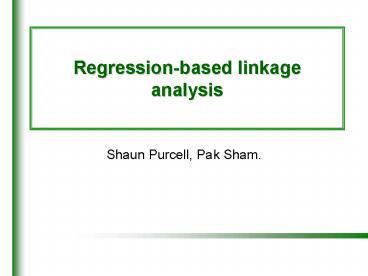Regression-based linkage analysis - PowerPoint PPT Presentation
Title:
Regression-based linkage analysis
Description:
Regression-based linkage analysis. Shaun Purcell, Pak Sham. Penrose (1938) quantitative trait locus linkage for sib pair data. Simple regression-based method ... – PowerPoint PPT presentation
Number of Views:47
Avg rating:3.0/5.0
Title: Regression-based linkage analysis
1
Regression-based linkage analysis
- Shaun Purcell, Pak Sham.
2
- Penrose (1938)
- quantitative trait locus linkage for sib pair
data - Simple regression-based method
- squared pair trait difference
- proportion of alleles shared identical by descent
3
Haseman-Elston regression
(X - Y)2
IBD
2
1
0
4
Expected sibpair allele sharing
5
Squared differences (SD)
-
-
-
-
-
-
Sib 2
Sib 1
6
Sums versus differences
- Wright (1997), Drigalenko (1998)
- phenotypic difference discards sib-pair QTL
linkage information - squared pair trait sum provides extra information
for linkage - independent of information from HE-SD
7
Squared sums (SS)
8
SD and SS
-
-
-
-
-
-
Sib 2
Sib 1
9
- New dependent variable to increase power
- mean corrected cross-product (HE-CP)
- other extensions
- gt 2 sibs in a sibship multiple trait loci and
epistasis - multivariate multiple markers
- binary traits other relative classes
10
SD SS ( CP)
-
-
-
-
-
-
Sib 2
Sib 1
11
Xu et al
- With ? residual sibling correlation
- HE-CP ? in power, HE-SD ? in power
12
Variance of SD
13
Variance of SS
14
Low sibling correlation
15
Increased sibling correlation
16
- Clarify the relative efficiencies of existing HE
methods - Demonstrate equivalence between a new HE method
and variance components methods - Show application to the selection and analysis of
extreme, selected samples
17
Haseman-Elston regressions
18
NCPs for H-E regressions
19
Weighted H-E
- Squared-sums and squared-differences
- orthogonal components in the population
- Optimal weighting
- inverse of their variances
20
Weighted H-E
- A function of
- square of QTL variance
- marker informativeness
- complete information 0.0125
- sibling correlation
- Equivalent to variance components
- to second-order approximation
- Rijsdijk et al (2000)
21
Combining into one regression
- New dependent variable
- a linear combination of
- squared-sum
- and squared-difference
- weighted by the population sibling correlation
22
HE-COM
-
-
-
-
-
-
Sib 2
Sib 1
23
Simulation
- Single QTL simulated
- accounts for 10 of trait variance
- 2 equifrequent alleles additive gene action
- assume complete IBD information at QTL
- Residual variance
- shared and nonshared components
- residual sibling correlation 0 to 0.5
- 10,000 sibling pairs
- 100 replicates
- 1000 under the null
24
Unselected samples
25
Sample selection
- A sib-pairs squared mean-corrected DV is
proportional to its expected NCP - Equivalent to variance-components based selection
scheme - Purcell et al, (2000)
26
Sample selection
27
Analysis of selected samples
- 500 (5) most informative pairs selected
r 0.05
r 0.60
28
Selected samples H0
29
Selected samples HA
30
- Variance-based weighting scheme
- SD and SS weighted in proportion to the inverse
of their variances - Implemented as an iterative estimation procedure
- loses simple regression-based framework
31
- Product of pair values corrected for the family
mean - for sibs 1 and 2 from the j th family,
- Adjustment for high shared residual variance
- For pairs, reduces to HE-SD
32
Conclusions
- Advantages
- Efficient
- Robust
- Easy to implement
- Future directions
- Weight by marker informativeness
- Extension to general pedigrees
33
The End































